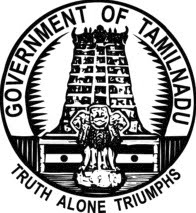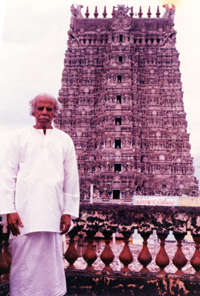|
In Tamil Nadu, it is on ourration cards. On our bus-tickets, driving licences and many other official documents. That the logo of the Government of Tamil Nadu is a temple tower (gopuram) is well-known. When asked which temple this gopuram belongs to, a majority would answer that it is of the Vishnu temple in Srivilliputtur. Wrong. The gopuram is not the entrance gateway of the Vatapatrasayee temple in the historic and sacred town of Srivilliputtur in Virudhunagar District. It in fact represents a gopuram similar in style – the west temple tower of the famous Meenakshi Sundareswarar temple in Madurai.

The State emblem. |
The artist who designed this monogram was Prof. R. Krishna Rao. Born in 1915, he completed his schooling in Madurai and, in 1942, joined the Government School (now college) of Arts and Crafts in Madras where he was allowed to complete the five-year course in three years as he was outstanding in his work. With a first class Diploma in Fine Arts, he first served in the War Publicity Department as an artist and, later, had a stint as a textile designer in a private firm in Gudiattham. In 1948, he was appointed Head of the Department of Applied Arts in the Government School of Arts and Crafts in Madras, subsequently promoted as Vice-Principal and transferred to the Government School of Arts and Crafts in Kumbakonam. In 1968, he was appointed the Principal of the Government School of Arts and Crafts in Madras when the renowned artist K.C.S. Paniker retired from that post. In 1972, Krishna Rao joined Kalakshetra, Madras, as Director, Department of Art.
It was Prof. R. Krishna Rao who conceived and designed the temple tower emblem of Madras State in 1949. A native of Madurai, he grew up in a large joint family living in a big house adjacent to the Meenakshi Sundareswarar temple. The vast temple complex, with its majestic gopurams, prakarams, numerous mandapams and sub-shrines had a mesmeric effect on him throughout his life. As a boy, he had spent countless hours going around the temple, studying its art and architecture. Krishna Rao painted many views of this temple, particularly its gopurams. Of all the temple entrances, he had a special liking for the one adorning the west entrance which ultimately became the monogram of the State of Madras that is now Tamil Nadu. He had once mentioned, “Hailing from Madurai, it is only proper that I should incorporate the Madurai temple in the State Government emblem.”

Prof. R. Krishna Rao in front of the West Gopuram of the Madurai Temple.
|
The nine-tier west gopuram of this temple which Prof. Krishna Rao chose for the monogram is one of the most aesthetically designed structures in South India. According to scholars, it was constructed in the 14th Century C.E. by a Pandyan ruler of Madurai named Parakrama Pandya. The famous fish crest of this dynasty and an inscription praising Parakrama Pandya are seen inside the entrance of this magnificent gopuram. Studded with stucco sculptures of mythological themes, most of them connected with manifestations of Lord Siva and Parvathi, the graceful contours of this tall edifice have attracted innumerable visitors.
Apart from the Meenakshi temple, Prof. Rao was fascinated by the stupendous architecture of the Brihadishwara temple in Thanjavur, constructed during the reign of Rajaraja Chola I in the 11th Century C.E. His many paintings of this temple, especially the colossal monolithic Nandi near the entrance, as well as his sketches of many other shrines won him much acclaim. His painting Entrance to the Temple Gate went into the permanent collection of the Tamil Nadu Lalit Kala Akademi and the National Gallery of Modern Art, Madras. In 1971, he designed the Government of Tamil Nadu raffle ticket with the motif of a boy raising his right hand.
Other than the temples of South India, Prof. Rao painted numerous views of the sacred city of Varanasi, the temples there and the devotees. He also chose themes from Hindu mythology and Christianity, landscapes, and street scenes for his sketches. His landscape, Cattle and Trees, was chosen for display in the first National Exhibition of Art at Jaipur House by the Lalit Kala Akademi, New Delhi. His famous quote was, “Either I paint to see my experience or aesthetics resounding on my canvas or I die by doing nothing.”
Prof. R. Krishna Rao, whose forte was water-colour painting, was much recognised and appreciated in his time and was bestowed with many an honour. In 1980, he was awarded a fellowship by the Tamil Nadu Ovia Nunkalai Kuzhu; in 1985, the title of Veteran Artist was conferred on him by the All India Fine Arts and Crafts Society (AIFACS), New Delhi; in 1991 he was honoured with the prestigious Kala Vibhushan by the then Prime Minister of India, Chandra Shekhar, and on January 1, 1995, he was bestowed the title of Chitra Kala Sagar by the Kanchi Kamakoti Peetham, a title he held very special. Many of his paintings are displayed in public and private collections in India and abroad.
Prof. Rao passed away in July 2006. How many think of him every time they see the emblem of the Government of Tamil Nadu, the west gopuram of the Madurai Meenakshi Sundareswarar temple?
|